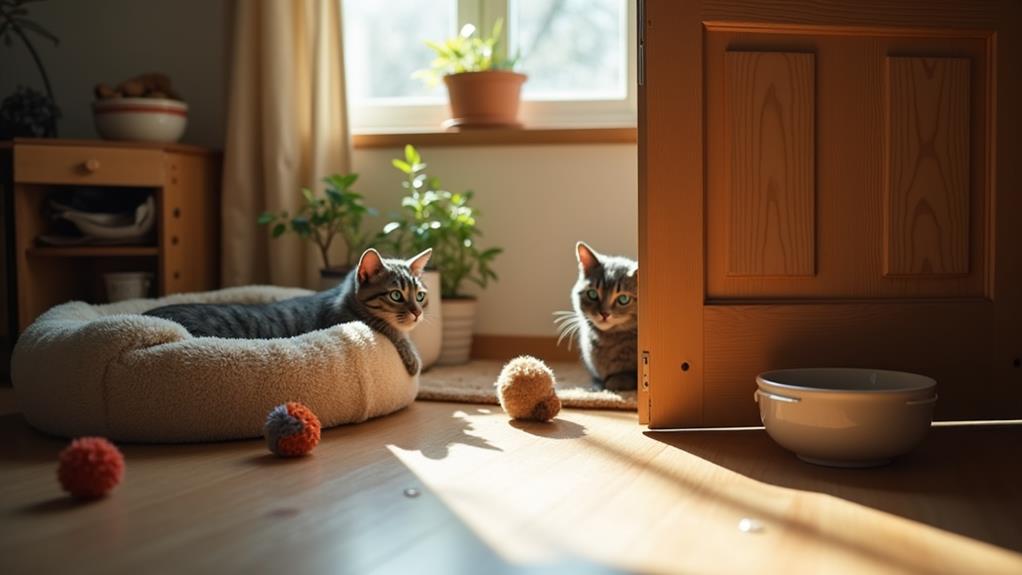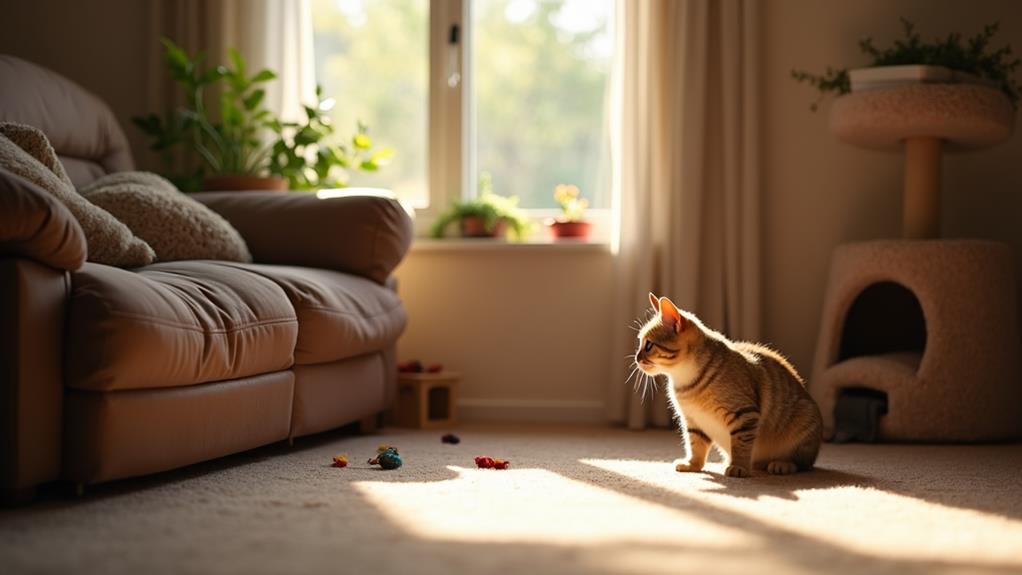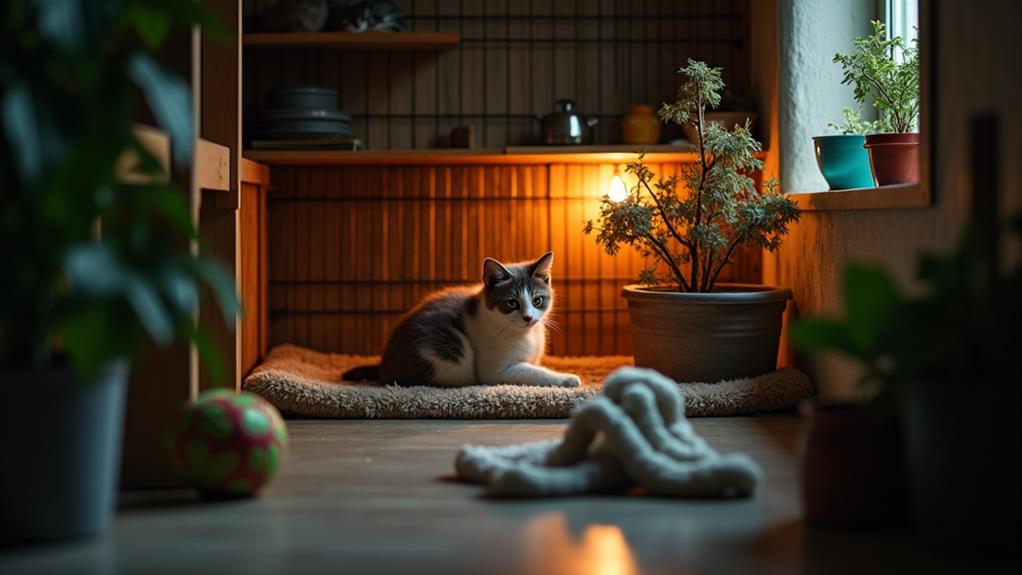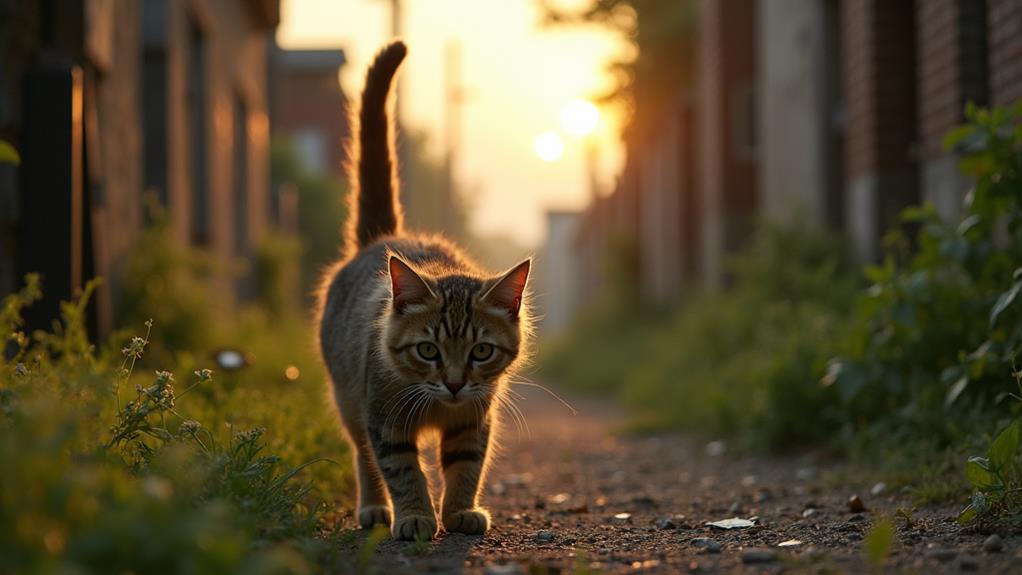How to Adopt a Feral Cat: Steps for a Successful Transition

Adopting a feral cat starts with understanding their often wary nature, as they're used to minimal human contact. Gather crucial supplies like a large cage and a cozy cat den to guarantee comfort. Build trust by establishing a consistent feeding schedule, using appealing food to slowly draw them closer. Create a safe, low-traffic environment indoors to help them feel secure. Move them into the home gradually, allowing them to investigate familiar scents and spaces at their pace. Commit to a long-term care routine with regular vet visits and tailored nutrition. Find out more steps to guarantee a smooth move ahead.
Understanding Feral Cat Behavior
Understanding feral cat behavior is essential if you're considering adopting one. Unlike stray cats, feral cats have minimal contact with humans, making them wary and inclined towards avoidance. They rely on their instincts to survive, often born outdoors, and have adapted to their environment. This means socializing an adult feral cat requires more patience and understanding of their unique behaviors.
Trust is the cornerstone of your relationship with feral cats, and it's built slowly. Establishing a reliable food source is significant. When feral cats know where they can get food regularly, they start associating your presence with positive experiences. This doesn't mean they'll approach you immediately, but over time, they'll feel more comfortable.
Patience is key, as rushing the socialization process often reinforces fear and avoidance. Gradual interaction helps you gain their trust without overwhelming them. Focus on creating a comfortable environment that allows them to investigate and retreat as needed. Feral kittens under eight weeks adapt more readily to human interaction, but adult feral cats can also progress with time. Remember, each cat is unique; understanding their cat behavior helps foster a successful adjustment into your home.
Gathering Essential Supplies
To begin the process of adopting a feral cat, gathering significant supplies is crucial for a smooth change. A large cage is key to the indoor confinement needed for your new feline friend, providing a safe space to adjust to its new environment. Here's a list of fundamental items you'll need:
- Large Cage: Choose one that's spacious enough for the cat to move around but secure to prevent escapes. This serves as the cat's initial home, allowing it to slowly acclimate.
- Cat Den: Place a small, enclosed shelter inside the cage to offer the cat a private retreat. This helps reduce stress and promotes a sense of security during the change.
- Clean Blankets and Newspaper: Line the cage with newspaper topped with clean blankets. This not only provides comfort but also absorbs any messes, maintaining a hygienic environment.
- Low-Traffic Area: Situate the cage in a quiet, low-traffic area like a spare bedroom. This minimizes disturbances, allowing the cat to feel more at ease.
Consider covering the cage with a sheet to create a more enclosed, comfortable environment. This aids in the trust-building process, helping your cat feel secure and reducing stress.
Building Trust Gradually

Patience forms the foundation of building trust with a feral cat. Start by establishing a regular feeding schedule with 2 to 4 small meals daily. This consistency helps create a sense of security and begins to build trust. Use appealing food, such as canned tuna or baby food, to make your presence more inviting. By offering something delicious, the cat will associate you with positive experiences.
During feeding times, practice gradual proximity. Sit nearby and allow the cat to get accustomed to your presence and scent without feeling threatened. Avoid sudden movements and loud noises, as these can reinforce the cat's wariness. Patience and persistence are essential in this socialization process. Over time, the cat will start showing signs of relaxation, like grooming or lying down comfortably.
Once the cat seems more at ease, consider introducing gentle physical contact. Approach this step cautiously and only when the cat appears relaxed and comfortable. Each cat is different, so the timeline for building trust will vary. Remember, the goal is to create a positive association with your presence, helping the feral cat feel secure and open to socialization.
Creating a Safe Environment
As you gain the trust of a feral cat, it is crucial to focus on creating a safe environment that encourages them to feel secure and relaxed. Start by providing a large cage lined with newspaper and clean blankets, offering a secure space for them to acclimate. Position this cage in a low-traffic area like a spare bedroom to reduce stress and foster comfort. Cover the cage with a sheet to create a cozy environment, making the cat feel more protected from potential disturbances.
To improve their adjustment, consider these steps:
- Set up a designated cat den: Within the cage, arrange a small area where the cat can retreat and hide. This hiding spot will offer extra security and help them feel less exposed.
- Observe their body language: Pay attention to signs of stress or relaxation, adjusting the environment as needed to promote comfort.
- Minimize sudden movements and noise: Maintain a calm atmosphere to aid successful acclimatization, ensuring the cat investigates their surroundings at their own pace.
- Monitor their comfort levels: Regularly check on the cat, making adjustments to their environment to support a smooth adjustment.
These strategies will help your feral cat feel at ease in their new home.
Transitioning Indoors Successfully

Shifting a feral cat indoors successfully requires a careful approach that prioritizes their comfort and safety. Begin by setting up a safe space, like a spare room or basement, where the feral cat can acclimate without feeling overwhelmed. This enclosed area allows them to investigate at their own pace and build confidence as they adapt to an indoor lifestyle. Include familiar scents and items, such as a blanket or bedding from their outdoor environment, to ease their anxiety and offer a comforting touchstone during this adjustment period.
Establish a consistent feeding routine to provide a sense of security and normalcy. Regular meals at the same time each day help the cat understand that this new indoor setting is their home and that they're safe. As the cat becomes more comfortable, gradually introduce them to different parts of your home, always ensuring they have the option to retreat to their safe space if needed.
Patience is essential during this adjustment. Monitor behavior closely, noting any signs of stress or anxiety, and give the cat time to adapt. Remember, each feral cat will have its unique timeline for fully embracing their new indoor lifestyle.
Committing to Long-Term Care
Successfully committing to the long-term care of a feral cat means establishing a consistent daily routine that includes feeding, playtime, and litter box maintenance. This routine fosters trust and makes the cat feel more comfortable in their new environment. Feral cats require ongoing care and attention to help them acclimate to indoor living. Here's how you can guarantee a successful change:
- Routine and Patience: Maintain a consistent schedule for feeding and playtime. Patience is essential as feral cats may take time to adjust and trust you. Respect their pace and avoid forcing interactions.
- Veterinary Visits: Schedule regular veterinary visits for health checks, vaccinations, and preventive care. These visits are important to monitor their health and address any issues promptly.
- Balanced Diet: Provide a balanced diet tailored to your cat's needs to maintain their energy levels and prevent obesity. Monitor their weight and adjust portions as necessary.
- Socialization Efforts: Engage in gentle socialization activities. Regular interaction and play will help the cat acclimate to their new home and build a trusting relationship with you.




